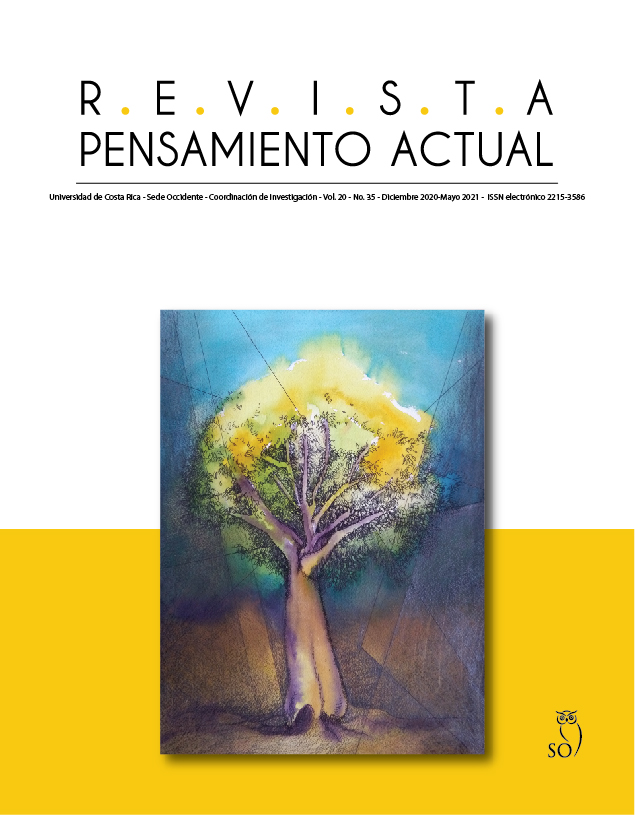Abstract
I studied the phenology of W. insignis (n =10), tree with great ornamental potential with conspicuous flowers, which grows on the San Lorencito riverbed, in the Alberto Manuel Brenes Biological Reserve, Alajuela, Costa Rica, June 2014 until October 2015. Of the selected sample of six individuals with flower production, the diameter at breast height ranged from 7 cm to 11.9 cm, while the highest trees measured 15 m. The identification of the individuals was done with plastic marks enumerated, after this they were georeferenced. In relation the flowering phenotypes (subanual), foliar sprouts, fall foliage were continuous, without having a total loss of the leaves. While the fructification was absent in October 2014 and June 2015. There was asynchrony between individuals in the behavior of the phenological stages. The fall of foliage (n = 10, r = 0.35, p <0.05) and flowering (n = 10, r = 0.46, p <0.05) correlated with precipitation while fruiting (n = 10), r = -0.51, p <0.05) had an inversely proportional correlation with this phenomenon.
References
Abdallah, M.A. et al (2011) A comparative study on red and white karade (H. sabdariffa L.) calyces, extracts and their products. Pakistan Journal of Nutrition 10, 680-693.
Boyle, A. y Bronstein, J. (2012). Phenology of tropical understory trees: patterns and correlates. Rev.biol.trop 60 (4). Recuperado de: http://www.scielo.sa.cr/scielo.php?script=sci_arttext&pid=S0034-
Brenes Cambronero, L. (1999). Autoecología de Elaeagia uxpanapensis D. Lorence (Rubiaceae), en la Reserva Biológica Alberto Manuel Brenes, San Ramón, Costa Rica. Tesis de Maestría. Universidad de Costa Rica, San Pedro de Montes de Oca, San José, Costa Rica.
Brenes Cambronero, L. y Di Stefano, J.F. 2001. Comportamiento fenológico del árbol Elaeagia uxpanapensis (Rubiaceae), en un bosque pluvial premontano de Costa Rica. Rev.Biol.Trop 49 (3-4): 989-999.
Brenes Cambronero, L. y Sánchez, R. (2017). Fenología de Talauma gloriensis Pittier (Magnoliaceae), Reserva Biológica Alberto Manuel Brenes,San Ramón, Alajuela, Costa Rica. Revista Pensamiento Actual (17):11-22
Carvalho – Sobrinho, J. (2013). A new species of Eriotheca (Malvaceae: from Espirito Santo, Eastern Brasil. Phitotaxa 108 (1): 49 -53.
Cheng, Z. (2001). Kenaf research products and applications in Japan. Plant fibres and products 23(3), 16-24.
Estrada-Conteras, I., Equihua, M., Castillo-Campos, G. y Rojas-Soto, O. (2015) Climate Change and effects on vegetation in Veracruz, México: An approach using ecological niche modelling. Acta Botánica Mexicana 112:-93.
Fleming, T., Geiselman, C. y Kress, W. (2009). The evolution of bat pollination: a phylogenetic perspective. Annals of Botany 104: 10137-1043.
Fournier, L. 1974. Un método cuantitativo para la medición de características fenológicas en árboles. Turrialba 24 (4):422-423.
Fournier, L. y Charpantier, C. (1975). El tamaño de la muestra y la frecuencia de las observaciones en el estudio de las características fenológicas de los árboles tropicales. Turrialba 25: 45-48.
Fryxell, P. (1981). Revision and expansion of the Neotropical Genus Wercklea (Malvaceae). Journal of the Arnold Arboretum (62): 457 – 486. García, E. y Di Stefano, J.F. (2004). Fenología de árbol Sideroxylon capiri
(Sapotaceae) en el Bosque Seco Tropical de Costa Rica. Rev. Biol. Trop 53 (1-2):5-14.
Gómez, R. (2010). Fenología reproductiva de especies forestales nativas presentes en la jurisdicción de CORANTIOQUIA, un paso hacia su conservación. Medellín (Colombia): Volumen I, 2010, p. 177 – 180.
Huxley, P.A. (1983). En: P. A. Huxley. Phenology of tropical woody
perennials and seasonal crop plants with reference to their management in agroforestry systems. Plant research and agroforestry. Nairobi (Kenia): International Center for Research in Agroforestry. Pp. 503-525.
La Rotta, C. (1987). La etnobotánica: una aproximación metodológica desarrollada con la comunidad indígena Miraña (Amazonas Colombia). Memorias del primer simposio colombiano de etnobotánica. Corporación de Araracuara, Editorial Gente Nueva, Bogotá, Colombia.
Mahadevan, N. and Shivali, K.P. (2009). Hibiscus sabdariffa L. An overview, Natural Product Radiance, 8:77-83
Mohta, D. (2000). Refiner Mechanical Pulping of Kenaf fibre: Such aprocess might reduce the demand for expensive softwood kraff pulps. Pulp and paper can. 101(8): 27-31.
Mooney, H.A., Bjorkman, A.E., Medina y Tomlinson, P.B. (1980). The study of physiological ecology of tropical plants -current status and needs. BioScience 30: 22-26.
Newstrom, L.E., Frankie, G.W. y Baker, H.G. (1994). “Una nueva clasificación para la fenología de plantas basada en patrones de floración en los árboles de tierras bajas del bosque lluvioso, de la Selva, Costa Rica”. Biotrópica 26 (2): 141- 159.
Odigie, J.P. y Adigun, S. (2003) Chronic administration of aqueous extract of Hibiscus sabdariffa attenuates hypertension rats. Journal of Ethnopharmacology 86: 181-185.
Ortiz, R. y Fournier, L.A. (1983). Comportamiento fenológico de un bosque pluvial de premontano en Cataratitas de San Ramón, Costa Rica. Rev. Biol.Trop. 31: 69-74.
Pérez, C.A., Villalba, J.C. y Almanza, M.I. (2011). Fenología del roble (Quercus humboldtii bonpland). Biotecnología en el Sector Agropecuario y Agroindustrial, Edición Especial No. 2, Popayán, Cauca, Colombia. pp.145–154.
Pérez, R., Condit, R. (2017). Tree Atlas of Panama. Smithsonian Tropical
Research Institute. Consultado el 9 de octubre de 2020. Disponible en: https://stricollections.org/portal/taxa/index.php?taxon=70915&clid=71
Pleasants, J. y Wendel, J. (2010). Reproductive and pollination biology of the endemic Hawaiian cotton, Gossypium tomentossum (Malvaceae). Pacific Science 64 (1): 45 – 55.
Richards, P. W. (1996). The Tropical Rain Forest. Cambridge, Londres.
Rojas, F., Bermúdez, G. y Jiménez, Q. (2016). Plantas ornamentales del trópico. II ed. Editorial Tecnológica de Costa Rica, Cartago, Costa Rica.
Rondón, J. (1992). Hábito fenológico de 53 especies arbóreas del Jardín
Botánico de San Juan de Lagunillas. Revista Forestal Venezolana 36: 23-33.
Sáenz, J., Nassar, M. (1965). Phytochemical Screening of Costa Rican
Plants: Alkaloid Analysis II. Rev. Biol. Trop 13(2):207-212.
Standley, P.C. (1937). Flora of Costa Rica, Part II. Studies of tropical American phanerogams
Standley, P.C., Pittier,H. (1916). Wercklea. Herb 18, 112.
Tate, J. (2003). Andeimalva, a new genus of Malvaceae from Andean South America. Lundella 1 (6): 10 -18.

